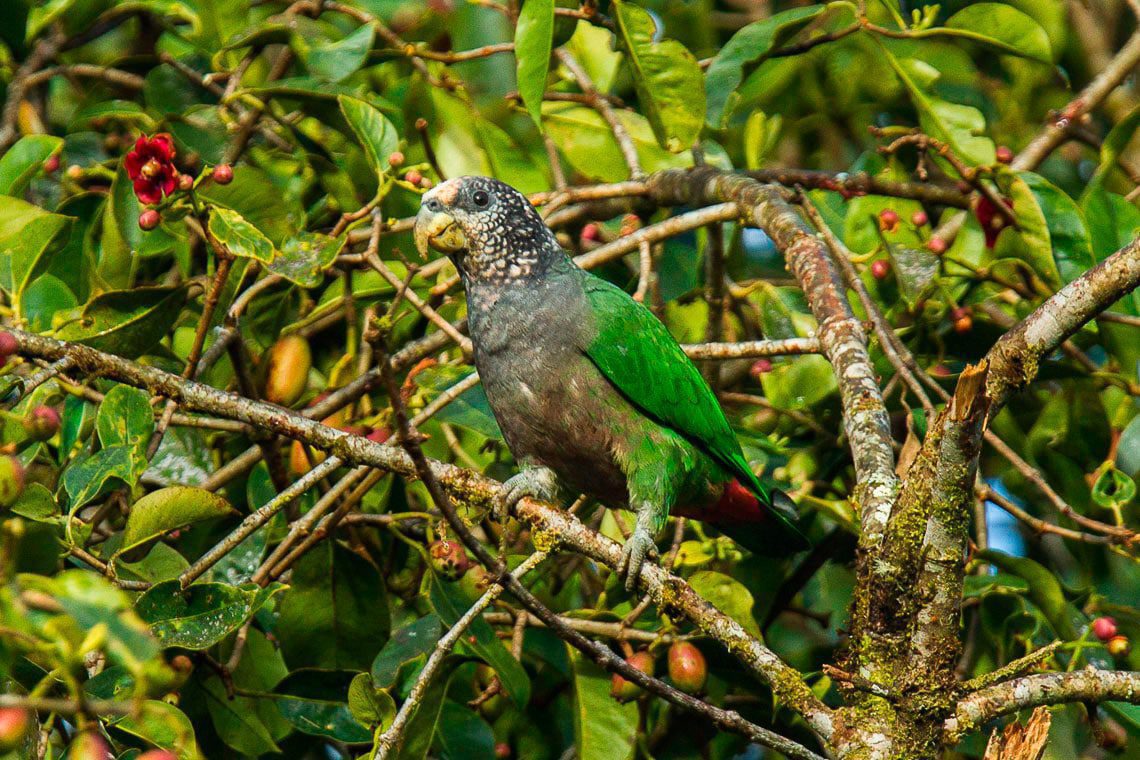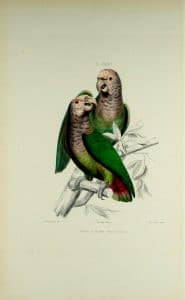Content
|
|---|
Description:
28 to 30 cm.. high and about 229 g. of weight.
The White-capped Parrot (Pionus seniloides) is easily identifiable by the “bill” yellow, head usually white, with the crown with reddish speckles, feathers of the nape and sides of the head with dark blue edges and red dyes which gives the appearance of flake.
Breast with greenish blue edges, under belly and internal base tail red.
Iris of color Brown and legs gray-green.
The youth have crown and chest green, and green spots on the sides of the head and neck.
Note:
Previously he was treated as a subspecies of the species Pionus tumultuosus, that is to say, Pionus tumultuosus seniloides. A midyear 2014 it is considered as own species.
- Sound of the White-capped Parrot.
Habitat and behavior:
It is a kind Rare.
It inhabits in humid jungle and edges, from the 1900 to 3000 m. It is mainly a species of temperate zone, but you can descend to lower elevations.
Like most highland parrots, the White-capped Parrot are rather nomads, widely wandering in search of fruits and seeds (now perhaps more as a result of extensive deforestation). Usually observed in flocks 3-25 birds, sometimes more. More active with grey weather, overcast skies. Difficult to see while feeding or resting in the upper canopy. Its silhouette in flight resembles a Amazona but with the beating of wings deepest.
Reproduction:
It nests in tree hollows.
Food:
Feeds of seeds, fruit of Turpinia paniculata and plants of the family Clusiaceae; sometimes in cornfields, causing damage to their crops.
Distribution:
Size of its range (reproduction / resident): 1.020.000 km2
Live west of Venezuela (from the border Trujillo–Lara) through the East of the Andes of Colombia (rare in the western Andes), and on both sides of the Andes in Ecuador and Northwest of Peru (west to Cajamarca and this, at least until Freedom)
Conservation:
• Current category of the Red List of the UICN: Least concern.
• Population trend: Decreasing.
Justification of the population
The size of the world population It has not been quantified, but this species is described as “quite common“, but irregular distribution (Stotz et to the., 1996).
Justification of trend
They suspected that the population is declining due to the continuous habitat destruction.
"White-capped Parrot" in captivity:
Rare in captivity. In Europe they arrived first at the beginning of the century 20 and then the early 70. In captivity, However, They were raised for the first time in the second half of the 80.
Alternative names:
– White-capped Parrot, Speckle-faced Parrot (White-capped), White-headed Parrot (English).
– Pione givrée (French).
– Greisenkopfpapagei, Glatzenkopfpapagei, Greisenkopf-Papagei (German).
– White-capped Parrot (Portuguese).
– Loro de Cabeza Blanca, Loro seniloide, Loro gorriblanco (español).
– Cotorra Cabeciblanca (Venezuela).
scientific classification:
– Order: Psittaciformes
– Family: Psittacidae
– Genus: Pionus
– Scientific name: Pionus seniloides
– Citation: (Massena & Souancé, 1854)
– Protonimo: Psittacus seniloides
Images “White-capped Parrot”:
|
|
|
|---|
Videos "White-capped Parrot"
————————————————————————————————
White-capped Parrot (Pionus seniloides)
Sources:
– Avibase
– Parrots of the World – Forshaw Joseph M
– Parrots A Guide to the Parrots of the World – Tony Juniper & Mike Parr
– Birdlife
– Parrot Book, Parrots and macaws Neotropical
– parrots.org
– Photos:
(1) – By Francesco Veronesi [CC BY-SA 2.0], via Wikimedia Commons White-capped Parrot (Pionus seniloides), Ecuador by
(2) – Iconographie des perroquets :Paris :P. Bertrand,1857 by Biodiversity Heritage Library – Flickr
– Sounds: Andrew Spencer



